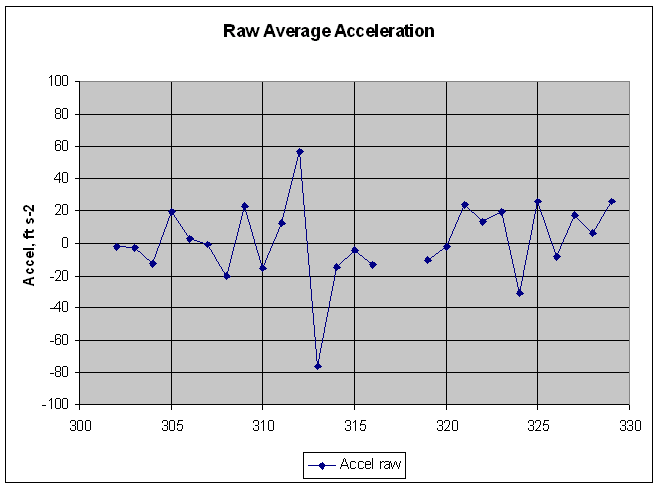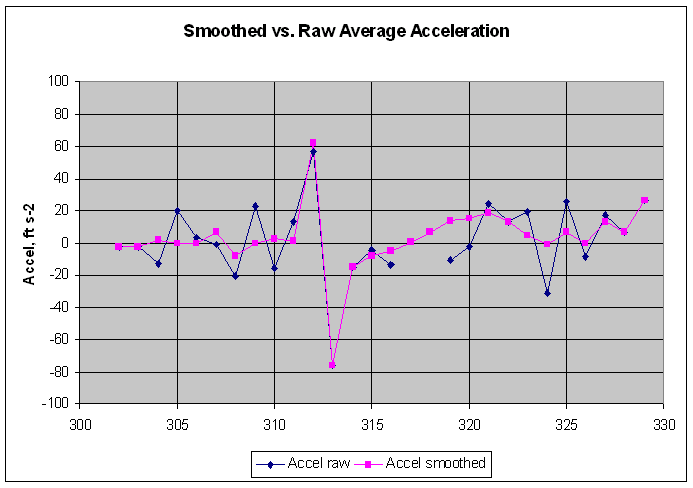
2a. Smoothing
Recall that frame 318 was too blurred for Josiah Thompson to provide a reliable position of the head from it. The first step in smoothing the data is thus to supply a position for frame 318. The default way to do this is to linearly interpolate between the values for 317 and 319, which amounts to averaging them because the steps are even. The result is shown below in Figure 1.

Figure 1. Raw position (with respect to 312) from Thompson's Appendix B, with frame 318 linearly interpolated.
The average velocity is just the first
derivative of the position. It is called average because it can only be
calculated for a full frame, not any point within a frame. It is calculated by taking the position of the head
in one frame, subtracting its position in the previous frame, and dividing by
the time difference (1/18.3 sec). The result is then plotted at the midpoint
between the two frames. For example, the average velocity between 301 and 302 is
plotted at 301.5. This makes one fewer point for velocities than for positions.
The average velocities are shown below in Figure 2.
It is important to note how much the noise of the
first-derivative velocity is magnified relative to the noise in the positions.
This negative effect can, however, be turned to a positive by using it as a sensitive way
to smooth the positions, understanding that velocities will vary smoothly in
cases other than violent events like bullet strikes. In other words, one
smoothes the positions by looking for the effect on velocity.
As with the position, the plot of velocity shows several
large-scale features. The first is a long area of near-zero velocity that
extends from frames 301.5 through 311.5. Then comes a single frame of fast
forward velocity (312.5), followed by an equally rapid return to rearward motion
at 313.5 and three more frames of increasing rearward velocity. That is followed
by a two-frame break, after which the velocities are higher and rapidly climb
through zero to increasingly positive values. That makes five major features
whose validity is to be tested.
At first glance, the key point in Figure 2 might seem to be
the reality of the huge forward speed in 312.5. But the more important
feature is the series of increasingly negative velocities in frames 313.5
through 316.5. This is the infamous "lurch," which began after the
explosion and is a direct or indirect consequence of it. The steadily increasing
rearward speed is central, for if real it requires a rearward force that extends
over several frames. This force cannot be momentum for a bullet, for that is
transferred instantaneously. It also cannot be the impulse from an explosion,
for that is also transferred nearly instantaneously. It's not gravity, for JFK
was too upright. About the only thing remaining is the infamous neuromuscular
reaction, of a general stiffening of the back muscles.
The other important aspect of the velocities in the lurch is
that they point back to the velocity coming out of the quick backward snap after
the explosion. Here the key element is the regularity of the four velocities in
313.5 through 316.5. If this pattern is genuine, it shows that the velocity
coming out of the explosion is something like -0.8 ft s-1,
independent of the position in the blurry frame 313. The question is
whether the pattern is genuine and solid. This is the major goal of smoothing the
points.

Figure 2. Raw average velocity. Points shown at midpoint of the two positions used to calculate them.
The raw average acceleration, shown below in Figure 3, is still noisier than the average velocity. This noise provides the most sensitive way to smooth the positions. It is justified because accelerations, which represent forces, must vary smoothly over the short single frames. The increasingly rearward velocities of frames 313.5 through 316.5 show up here as roughly constant negative accelerations around 10 ft s-2, most likely representing the muscular stiffening. Again, the main goal of smoothing the positions is to see whether these three accelerations retain their similar negative values. If so, they and the velocities associated with them for a target for calculating the physical recoil from the explosion.

Figure 3. Raw average acceleration. Points shown at midpoint of the two velocities used to calculate them.
An interactive Excel file
The actual process of smoothing the data is highly
interactive. You first identify a point that appears out of place, then change
its value and see how the updated plots of position, velocity, and acceleration
appear. If the position could be adjusted better, you do it and check the three
plots again. Then you turn to another point and repeat the process. It's a long
job. You stop when you have worked with all the points that can be justifiably
adjusted, and when reasonably smooth patterns result. The whole process should
be kept to a minimum. You keep it under control by never straying beyond the
bounds imposed by physics and the Zapruder film.
I believe that every serious student of JFK's motions after
the head shot needs to experience this smoothing process hands-on. To make that
possible, I have created a small Excel file with the relevant columns for raw
and smoothed position, velocity, and acceleration, along with linked plots of
the three sets of raw vs. smoothed values (corresponding to figures 4 through 6 below). This file can be downloaded by clicking here.
The smoothed columns contain the raw data except for the addition of an
interpolated position for frame 318. The idea is to manipulate the data in the
column for smoothed position (the one in red) and watch how the three plots
respond. If the smoothing process goes too far, it can be restarted by copying
the raw data back to the smoothed columns or by downloading the file again.
(Restarts are to be expected—it originally took me several tries to get
comfortable with the smoothing process when I began with it several years ago.)
The discussion below begins with my final smoothing.
Smoothing the data
The first point to be changed is the position in 315, which
is a little low. That produces a smoother change in velocities through the first
part of the rearward lurch. Next are points 319 and 320, with the first being
raised and the second lowered. That produces a smooth increase in negative
velocities around 320 as JFK's body is beginning to feel the forward push of the
seat.
Next comes 324, which is clearly too high. Putting it in line
with the points on either side of it creates a near-constant series of
velocities near 1.5 ft s-1, which represents JFK's
"coasting" forward after bouncing off the seat and before gravity
starts to pull him further forward. Then comes a minor adjustment downward to
326, to round out that long sequence of forward motion.
The next adjustments fall in the initial series of points,
from 301 through 312. It is clear from the film that JFK's head is not moving
perceptibly here, and certainly not sharply. Accordingly, I have smoothed the
points into a long series of gradually declining positions. In response to the
unblurred points shown in Figure 2 of section 38a, I weighted the higher points at the
beginning and the lower points at the end. That produced a series of velocities
centered just below zero and a series of accelerations right on zero.
The last decision for smoothing is 313 and 314. Position 313
is surprisingly easy to deal with, given that the frame is so blurred. One
simply notes (1) that the back of the head is quite sharply defined, and can be
measured easily, and (2) the limited effect of blurring is confirmed by a darker
zone just to the left of the head. In other words, you are home free because can
see both the sharp back of the head and the modest blurring behind it. The
position in 313 can be combined with that in 312 to give a well-defined distance
of snap between the two.
These last sentences are misleading, however, for the record
of the explosion and flying fragments in 313 signify that the head had exploded
before the end of 313 and was therefore already moving backward. Thus the
displacement between 312 and 313 is net rather than gross—the head had snapped
farther forward and was already moving backward by the end of 313. This makes
the distance measured between 312 and 313 a minimum rather than a total.
There is another reason to keep the position in 313 where it
was measured to be: its effect on the rearward velocities that follow it. If 313
is raised, the velocity in 313.5 is lowered (made more negative), which then
takes away from the sustained rearward acceleration ascribed to a muscular
stiffening. Take away enough acceleration, and one could be left with more like
three points of constant rearward velocity instead of acceleration. A faster
rearward velocity coming out of the explosion would then substitute for most or
all of the stiffening. The physical recoil from the explosion would then be even
greater than it appears now, and inherently less probable. This would amount to
replacing two reasonable explanation with one less-reasonable one. Logically
speaking, the initial two mechanisms make more sense.
What about frame 314? Repeated viewing of the film confirms
that it is moving backward by 314, as the explosion requires it to be. Thus
leaving 314 where it is satisfies the film, the physics, and and smooth pattern
in Figure 4. The alternatives are untenable. Thus there seems no way to avoid
the extended rearward acceleration during the lurch.

Figure 4. Smoothed vs. raw positions.
The smoothed velocity shows the lurch beginning at -0.8 ft s-1 and accelerating to something like 2.4 or 2.5 ft s-1 before JFK encounters the rear seat. This confirms that the target velocity after the explosion is -0.8 ft s-1. The seat accelerates JFK to a forward speed of about 1.5 ft s-1, where he stays for a few frames until somewhere around 327 or 328 he begins to accelerate forward, presumably under the influence of gravity.

Figure 5. Smoothed vs. raw average velocities.
Figure 6 allows us to summarize the forces
that acted on JFK's head and body around the time of the head shot. First there
was the forward snap from the bullet, in frame 313. That was immediately
followed by a rearward snap in 314 caused by the explosion. Then came three
frames of rearward force from muscular stiffening. The stiffening was followed
by six or seven frames of forward force from contact with the rear seat. By 324
or 325 that force had petered away to nothing (as he was no longer in contact
with the seat). Beginning in 327 or 328, he was forced forward into his wife's
lap, presumably by the pull of gravity.
These five sequential forces are the story of JFK's movements
after the head shot. Bullet strike, explosion and recoil, muscular stiffening,
bouncing off the seat, and pull of gravity.

Figure 6. Smoothed vs. raw average accelerations.